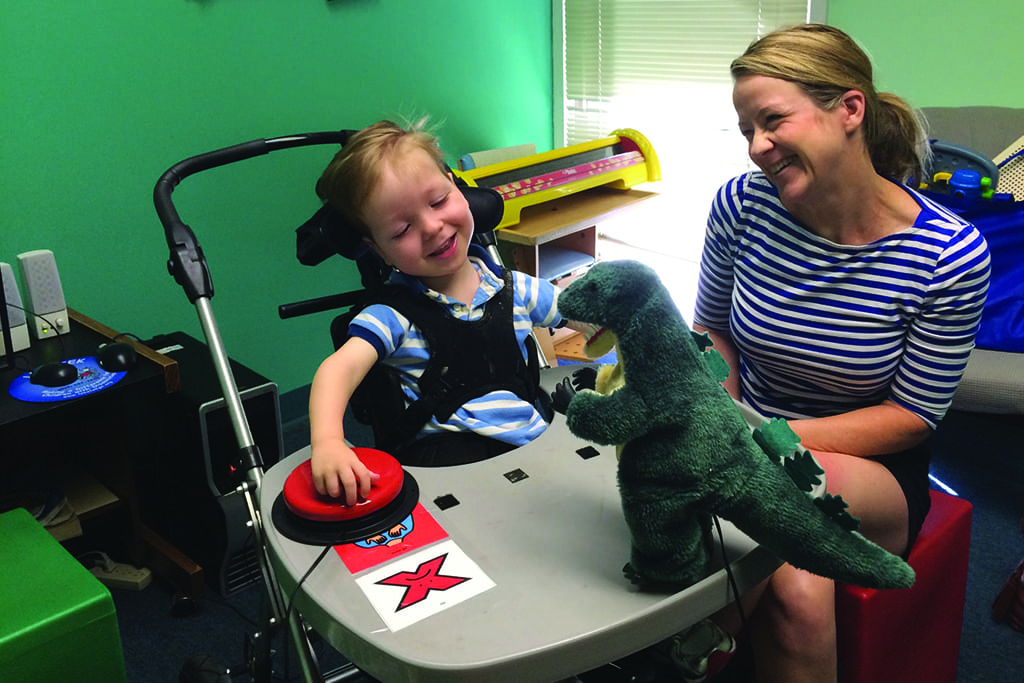Let’s Talk Tech: Screen Time
Technology — many of us have a love/hate relationship with this necessity of modern life. But, how does it really affect our kids?
On average, school-aged children spend 7.5 hours in front of a screen for entertainment each day, which amounts to 114 full days, not including time spent on screens at school or for homework. This accounts for a 17% increase since the pandemic.
In this series, Atlanta Parent will explore the impact of screen time and offer practical tips for managing it at various stages of development. Other topics include online safety, cyberbullying, social media and the right time to introduce devices because, as we all know, these things are unavoidable.
In 1895, residents in Paris were first entertained by moving pictures on a screen; by 1951, 12 million American homes had television sets. In the 1980s, computers entered homes and, in 1997, the iPhone was introduced.
Screens — no matter the size or function — are here to stay making the management of time spent in front of them a key part of daily life. There is no one size fits all solution; consider your own comfort level with technology and screen time, as well as the age(s) of your child(ren).
Recognizing the impacts of screen time as a whole is also essential. It is proven that when the number of hours in front of a screen goes up, psychological function goes down. This can make children more edgy, leading to depression and anxiety. More screen time also means less time to practice in-person social skills and be active. Finally, using screens more gives children a false sense of immediacy and the ability to control things, neither of which exist in real life.
Table of Contents
Age Matters
“Technology has changed almost every aspect of childhood,” says Katherine Martinko, author of the new book, “Childhood Unplugged: Practical Advice to Get Kids Off Screens and Find Balance,” “from how kids spend their time, to what they expect from life, to what we as adults expect of them, to what and how they learn and love.”
Screen time matters for every age and stage. “When looking at guidelines and thinking about what is right for your family, I urge people to ask themselves a few questions,” says Jody Baumstein, a Child Advocacy Program Specialist in Behavioral and Mental Health with Children’s Healthcare of Atlanta. “What is important at each stage of life? What types of things are kids missing when they are on screens? Are we overall healthy and mentally well? Are we making quality connections with our family members and friends?”
The American Academy of Pediatrics (AAP) has staggered guidelines regarding screen time for children based on brain development and other criteria since it can negatively impact sleep, attention, focus and language skills.
- Babies: It’s important to start here. “Babies learn from people not screens,” says Baumstein. “Interaction with the parents is a baby’s foundation for healthy relationships and trust.” The AAP’s guidelines note that children ages 2 years and younger should have no screen time, except an occasional video chat with out-of-town family. While this might sound daunting to a new parent, Martinko notes an important point: Babies don’t need devices to be distracted. “It’s too hyper-stimulating for them and they won’t know what they are missing if you don’t introduce screens.”
- Toddlers: The AAP says one hour per weekday and three hours daily on the weekends of quality, co-viewed screen time is appropriate for children ages 2-5. The challenge here is that when parents are busy, screens are an easy babysitter. “Sure, the device keeps them calm and contained in the moment, but that can backfire,” says Baumstein. “They don’t know how to control emotions or be creative when they spend all their time in front of a screen.”
- School Age: “The strategy for kids once they start school is delay, delay, delay,” says Martinko. The AAP suggests that this is the stage when teaching proper habits for screen time is key and to keep screens out of bedrooms and disallow use 30-60 minutes before bedtime, even for teens. “Within your home, set strict boundaries and promote imaginative play and projects,” she notes. Baumstein urges parents to think about balance for older children. “If school tech has been busy on a certain day, free time on screens isn’t a must. Screen time is a want.”
Setting Limits
“If you think parenting is tough, parenting a child AND their technology is even harder,” says Ben Halpert, Founder, President of Savvy Cyber Kids, an Atlanta-based non-profit founded in 2007 to provide parents the tools they need to educate and empower their children to make appropriate decisions in today’s world filled with technology. “Parents need to let their kids know that they, the parents, are in charge (really!), but that they are their partner in making sure they have safe online experiences. Setting ground rules is key.”
Why are limits and ground rules so important? Because kids don’t have the ability to self-regulate until their mid-20s when their brains are fully developed. “It’s our responsibility to create these limits,” says Baumstein. “We have to be thinking about the long-term impact, not the short-term goals of stop crying, don’t bother us. If we want our kids to be able to function in real-life situations, we can’t shove a screen in their faces.”
For parents with babies and toddlers, having structure can help set limits. “Create a daily routine,” says Martinko. “It’ll help the child to be less bored and help parents fill the time without devices. The smile reflex can’t develop without face-to-face interactions, so it’s critical to development that babies get face time with their parents and other loved ones, not screen time.”
According to Halpert, limits and rules have to be clear and set up in advance of getting a device or changing screen time allowances. He suggests using a tool like a pledge to keep everyone on the same page and safe. Savvy Cyber Kids offers a free, customizable one online at savvycyberkids.org/technology-pledge.
When setting limits for screen time, especially if this is a reset for your family, be sure to use the opportunity as a teaching tool and not to punish or control. Baumstein suggests explaining “the why” for setting screen time limits; kids are naturally curious and when they understand why guidelines are being set, they are likely to accept things more quickly and adapt the good habits. Remember that you are the adult and screen time is a privilege not a right, so reducing screen time doesn’t make you a mean parent.
Modeling is also key for helping create healthy screen time habits and setting limits with kids. “We, adults included, are attached to our phone and it limits our ability to be present and interact with the people around us,” says Baumstein. “The screen becomes an impulse and an addiction. We can’t just experience the normal feeling of discomfort. Kids aren’t learning to keep their eyes up and engage in small talk; they are looking down on their phones and avoiding these feelings because they don’t know how to work through them.”
Martinko recommends giving children reasons for your phone or device usage. “Explain that you’re making plans to see grandma later or looking up a recipe for dinner,” she says. “It gives the action purpose and also helps you be more aware of your own scrolling behaviors.” She also says to embrace offline habits such as reading, doing arts and crafts and going outside.
Creating structure around screen time for the family is another way to model healthy screen time habits. “The whole family can take a technology Shabbat,” says Martinko. “This is a 24-hour period where everyone takes a break from technology and uses the time to reconnect as a family.” Do it once a week, once a month, or even once a year. For older kids and teens, she also recommends developing seasonal leisure plans, which are highly tangible and doable. “Have your child set a large goal such as getting fit before a sports season starts, earning money for a trip or getting a job. Then, they make a schedule per week for managing their time to achieve that goal. It helps them build character and develops much-needed time management skills, while keeping them off of their screens.”
Whether it’s building a routine or just being more mindful, remember that kids are always watching. More often than not, they do what you do, not what you say. “When you are constantly on your phone or always have the TV on, what does that say to your kids silently?” notes Baumstein. Even if being more aware is just a decrease in screen time, that’s still a positive change and good modeling for your children.
“I am pro technology,” says Martinko. “The internet and smartphones have enabled so much — research, learning, communication, entertainment — my concern is around what is lost when screen time takes over too much time.”
The bottom line, healthy screen time habits that are developed while they are young will help children be more productive, happy and well-adjusted adults.
Screen Time Limit List
Here are some key guidelines to follow:
- Limits must be clear. When and where can it be used? How can it be used — public or private?
- Co-view shows, videos, and apps to build responsibility during screen time.
- No devices in their bedrooms.
- Create screen free zones in your home or rules such as no screens at the dinner table.
- Gradually reduce screen time by 30 minutes each week to get to where you want to be.
- Be consistent.
- Remember, it’s okay for kids to be bored!
- When you are talking to your kids about screen time rules, ask them:
- What do we gain by reducing screen time?
- How do you feel after you’ve been on your screen for a while? How does your body feel? What are you thinking about?
- What can we do instead of being on a screen? Let’s get creative!
Alternative Options
We are all so attached to technology, it can be difficult to think of other activities to keep the kids (and the adults) busy and happy. Here are some fun and simple offline things to do:
- Read or tell stories
- Do an arts and crafts project
- Play board games
- Go outside for a nature walk or family bike ride
- Play sports
- Bake a cake
- Plant herbs or flowers in the yard
- Schedule an old-fashioned, in-person playdate
- Put on a skit
- Paint a family portrait
- Let everyone get bored… who knows what creative ideas will be born!
-Tali Benjamin









